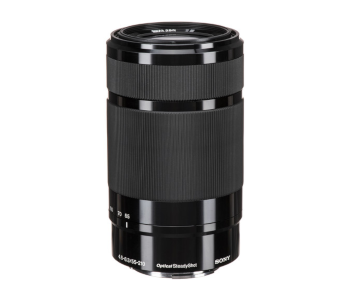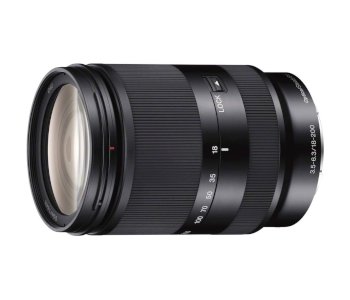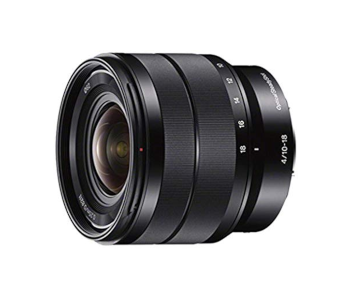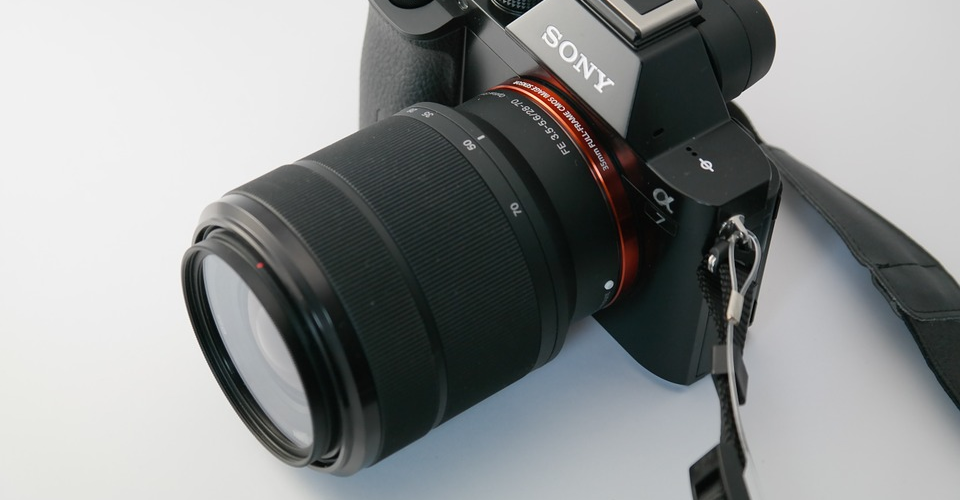6 Best Sony E Mount Lenses of 2020
Sony makes some of the best APS-C mirrorless cameras on the market. They’re compact yet pack numerous advanced features like 4K video, fast burst speeds, and autofocus systems that will push any compatible lens to its limit. The kit lenses you get with them are good for casual photography. However, investing in dedicated lenses based on the type of work you do most frequently will produce better results.
There’s a wide variety of choices at your disposal, so we’ve narrowed the search down to the six best Sony E mount lenses to speed things up. We cover wide-angle, telephoto, and everything in-between. Have a look, and treat your camera to a brand new perspective.
| Budget |
|---|
 |
| Sony E 55-210mm f/4.5-6.3 OSS |
| 4.1/5.0 |
| Type: Telephoto zoom |
| Image stabilization: Yes |
| Wide focal length at a reasonable price. |
| Check BH |
| Best Value |
|---|
 |
| Sony SEL35F18 35mm f/1.8 |
| 4.5/5.0 |
| Type: Standard prime |
| Image stabilization: Yes |
| Fast lens that performs well in low light. |
| Check Amazon |
| Top Pick |
|---|
 |
| Sony 18-200mm F3.5-6.3 OSS |
| 4.7/5.0 |
| Type: Telephoto zoom |
| Image stabilization: Yes |
| Excellent optical properties regardless of settings. |
| Check Amazon |
Sony E Mount Lenses Comparison Table
| Image | Product | Overall Rating | Image quality | Build quality | Features | Price |
|---|---|---|---|---|---|---|
 | Sony 18-200mm F3.5-6.3 OSS | 4.7 | 4.7 | 4.6 | 4.7 | Check Price |
 | Sony SEL35F18 35mm f/1.8 | 4.5 | 4.4 | 4.5 | 4.5 | Check Price |
 | Sony E 50mm f/1.8 OSS | 4.4 | 4.5 | 4.3 | 4.4 | Check Price |
 | Sony E 10-18mm f/4 OSS | 4.3 | 4.4 | 4.3 | 4.2 | Check Price |
 | Sony E 30mm f/3.5 Macro Lens | 4.3 | 4.3 | 4.2 | 4.3 | Check Price |
 | Sony E 55-210mm f/4.5-6.3 OSS | 4.1 | 4.3 | 3.8 | 4.2 | Check Price |
1. Best Overall – Sony 18-200mm F3.5-6.3 OSS
Editor’s Rating: 4.7/5
Photographers often agonize about what lenses to buy, so why not get one that’s an excellent all-around performer? The Sony 18-200mm F3.5-6.3 has an 11x zoom and covers a full-frame equivalent focal range from 27 to 300mm. That’s enough to shoot landscapes through portraits to capturing subjects that are far away. The lens features an accurate servo motor, has great build quality, and its price has gone down. Don’t let the age fool you – this is still the most versatile Sony APS-C lens out there.
Overview of Features
Sony did not skimp out on using the best materials when crafting this lens. You’ll see it right away in its rugged aluminum build that’s tough yet light enough for easy transportation. Closer inspection reveals grippy zoom & focus rings you can fine-tune effortlessly, as well as a lack of extending parts you’ll love if you use ND filters. The lens has a bayonet mount for the included hood that does a decent job of preventing excessive light from spoiling your shots.
While it isn’t the fastest performer when it comes to autofocus, the Sony 18-200mm F3.5-6.3 OSS is accurate and quiet. Its servo motor excels at delive3rig soundless, smooth zooming motions perfect for recording video. Once acquired, subjects stay in focus with minimal effort. You don’t need to rely on a tripod as the lens has built-in image stabilization that neutralizes camera shake and allows for four more stops than an unstabilized model.
The Sony 18-200mm F3.5-6.3 OSS’s optical properties are outstanding for a superzoom. Sharpness is its main selling point as it is maintained admirably throughout the focal range. The image’s center is always detailed, while the edges hit a sweet spot at 70mm with an f-stop of f/8. Even when you zoom all the way out, edge sharpness remains more than adequate. Chromatic aberration is a slight concern only at 18mm, while barrel distortion can be corrected after the fact.
What We Didn’t Like
The Sony 18-200mm F3.5-6.3 OSS has a low maximum aperture that decreases as you zoom in. That makes it unsuitable for low light and sports photography. There’s pronounced vignetting at the 18mm end as the edges are almost 2 EV stops darker than the rest of the image. Clever compositions and a slight zoom will do much to improve this, though.
| Tech Specs |
|---|
| Dimensions: 3 x 3 x 3.9 in. |
| Weight: 18.5 oz. |
| Type: Telephoto zoom |
| Minimum focal length: 18mm |
| Maximum focal length: 200mm |
| Maximum aperture: f/3.5-6.3 |
| Minimum aperture: f/22-40 |
| Minimum focus distance: 11.8 in. |
| Viewing angles: 76° to 8° |
| Image stabilization: Yes |
| The Pros |
|---|
| Exceptionally versatile range |
| Excellent optical properties regardless of settings |
| Light and built to a high standard |
| Servo motor creates smooth zooming motions that look great on video |
| The Cons |
|---|
| Pronounced vignetting at the minimum focal length |
| Not the best performer in low light |
2. Best Value – Sony SEL35F18 35mm f/1.8
Editor’s Rating: 4.5/5
Prime lenses aren’t as flexible as zooms, but you can get one with outstanding optics at a reasonable price. The 50mm equivalent focal range is ideal for most types of photography, and the SEL35F18 35mm f/1.8 is the APS-C lens to get for it. You can look forward to stunning portraits in low light or action shots without a hint of blur when using the lens. It’s stabilized, quiet, and light. In other words – almost perfect.
Overview of Features
The SEL35F18 35mm f/1.8 is a featherweight standard prime lens you’ll have no excuse not to bring on any shoot, just in case. Its outer shell is aluminum, while the inner casing that houses its elements is made out of plastic. There are front and rear caps to protect the outermost glass along with a petal-shaped hood that takes seconds to attach. The single focus ring is wide enough for a sure grip and reacts to changes in rotation speed.
Sony has outfitted the lens with Optical Steady Shot stabilization that compensates for three stops when using it in the field. You may focus manually or let the reliable AF do its job. Its speed isn’t remarkable, but the motor driving the autofocus ensures silent operation.
A wide aperture is the lens’s defining trait. An f value of 1.8 lets you create long exposures and work in conditions too dark for lesser glass. A shallow depth of field is a pleasant byproduct of shooting at high apertures. The lens does an excellent job of putting a subject into focus and isolating it from the surroundings. You’ll love it for portraits, product photography, and even for sports since the wide aperture accommodates fast shutter speeds.
What’s Bad About It?
The SEL35F18 35mm f/1.8‘s overall optical properties are solid as it’s a sharp performer and exhibits no barrel distortion. Color fringing is a problem, though, especially at f1.8. It’s most noticeable in contrasting surroundings, so try to frame your shots in a way that makes the bokeh look more uniform. We wouldn’t recommend this lens for videos since its autofocus slows down significantly and starts hunting even when there’s enough light.
| Tech Specs |
|---|
| Dimensions: 2.5 x 2.5 x 1.8 in. |
| Weight: 5.4 oz. |
| Type: Standard prime |
| Focal length: 35mm |
| Maximum aperture: f/1.8 |
| Minimum aperture: f/22 |
| Minimum focus distance: 11.8 in. |
| Viewing angle: 44° |
| Image stabilization: Yes |
| The Pros |
|---|
| Excellent value for the money |
| Fast lens that performs well in low light |
| Produces beautiful, creamy bokeh |
| Sharp across the board and free from distortion |
| The Cons |
|---|
| Pronounced color fringing at f/1.8 |
| Autofocus is slow in video mode |
3. Sony E 50mm f/1.8 OSS
Editor’s Rating: 4.4/5
The E 50mm f/1.8 OSS is a prime lens at the lower edge of telephoto territory. That means it’s great for portraits which focus exclusively on the subject. A max aperture of 1.8 lets you play around with light and pull off some fabulous contrasting results. The lens is compact, has no deal-breaking optical shortcomings, and is among the least expensive in Sony’s E mount lineup.
Overview of Features
The E 50mm f/1.8 OSS continues Sony’s trend of smartly-designed and functional E mount lenses. At 7 ounces, it isn’t heavy and doesn’t look bulky on Sony a 6000-series cameras either. The aluminum frame comes in two colors and is accompanied by a large circular hood. The elements remain stationary while focusing, as do the filter grooves.
Even though it’ll find most use as a portrait and cityscape lens, the E 50mm f/1.8 OSS has quick autofocus. Accuracy is high as well, and a large aperture ensures that indoor shots turn out as well portraits made out in the open. There’s no AF/MF switch, but manual focus is available through a wired connection. Focusing manually is both precise and silent since no mechanical movement is involved.
The lens’s sharpness is characterized by consistently great central results and varying levels of edge fall-off. A single stop is enough for marked border quality improvement, while f/2.8 is the sweet spot where smooth bokeh meets print-worthy image quality. It’s worth taking a hit to edge fidelity when doing portraits as the bokeh at 1.8 is among the finest we’ve seen on an APS-C lens. Pincushion distortion is all but absent, while chromatic aberration is tolerable.
What We Didn’t Like
This is another lens with noticeable vignetting. At f/1.8, the corners are 1.5EV darker than its center. The lens has trouble with autofocus when your camera is set to face detection. It struggles to find targets and can’t settle on a distance. You’ll either need to keep the focus in AF-C or help it manually.
| Tech Specs |
|---|
| Dimensions: 2.4 x 2.4 x 2.4 in. |
| Weight: 7.1 oz. |
| Type: Standard prime |
| Focal length: 50mm |
| Maximum aperture: f/1.8 |
| Minimum aperture: f/22 |
| Minimum focus distance: 1.3 ft. |
| Viewing angle: 32° |
| Image stabilization: No |
| The Pros |
|---|
| Bright, fast lens that’s perfect for portraits |
| Minimal distortion and color fringing |
| High central sharpness regardless of aperture |
| Excellent bokeh quality |
| The Cons |
|---|
| Pronounced vignetting at f/1.8 |
| Autofocus behaves erratically when combined with face detection |
4. Sony E 10-18mm f/4 OSS
Editor’s Rating: 4.3/5
Sony APS-C camera owners aren’t spoiled for choice when it comes to wide-angle zoom lenses. Thankfully, the E 10-18mm f/4 OSS impresses with tits optics, light yet durable build, and versatility. It’s a strong performer and solid choice whether you’re into landscapes, urban photography, or the occasional claustrophobic shot.
Overview of Features
The E 10-18mm f/4 OSS follows most of Sony’s E mount lens design principles. It’s squat and light for a wide-angle zoom lens. Plastic is its main building material, with the mount itself being metal. The front glass is slightly rounded but can still accommodate ND filters. Its two rings are knurled and easy to operate; the focus ring rotates freely while the zoom ring has four clearly marked stops ranging from 10 to 18mm. These correspond to 15-27mm in full-frame terms.
Wide-angle lenses don’t benefit as much from image stabilization as other models. Still, we’re glad that the E 10-18mm f/4 OSS has it since it leaves you free to shoot from the hand and leave your tripod at home. The IS compensates for three stops and makes for jitter-free images. Autofocus performance is great when there’s ample light. Lower light levels make for slower response times, but that’s what you’re signing up for with any wide-angle lens.
Barrel distortion is another thing you’d expect from such a lens, and the E 10-18mm f/4 OSS controls it very well. Chromatic aberration isn’t an issue either, especially at 14mm and above. Central image sharpness ranges from good to excellent. Vignetting is problematic only at f/4.
Are There Drawbacks?
The E 10-18mm f/4 OSS’s edge sharpness is poor at a wide-open aperture and high focal lengths, forcing you to step to f values as low as f/11 at 16 and 18mm. The drop-off in resolution is apparent and results in softness and loss of edge detail. The lens costs as much as our winner but isn’t as adaptable. Off-brand models might offer more value for the money.
| Tech Specs |
|---|
| Dimensions: 2.8 x 2.8 x 2.5 in. |
| Weight: 7.9 oz. |
| Type: Wide-angle zoom |
| Minimum focal length: 10mm |
| Maximum focal length: 18mm |
| Maximum aperture: f/4 |
| Minimum aperture: f/22 |
| Minimum focus distance: 11.8 in. |
| Viewing angles: 109° to 76° |
| Image stabilization: Yes |
| The Pros |
|---|
| Light for a wide-angle lens |
| Chromatic aberration and distortion are controlled well |
| Image stabilization is helpful for snapping photos without a long setup |
| Precise focus ring |
| The Cons |
|---|
| Expensive for what it offers |
| Makes images with soft edges |
5. Sony E 30mm f/3.5 Macro Lens
Editor’s Rating: 4.3/5
You need a macro lens if you want to capture small subjects from up close, and the E 30mm f/3.5 is an inexpensive lens that’s right for the job. It features speedy autofocus, is simply designed, and can work in a pinch for landscapes or portraits if you don’t mind the edge resolution fall-off.
Overview of Features
We love the simplicity of the E 30mm f/3.5’s design. It has a silver metal body, and the internal components are held together by plastic. There are no physical controls except a wide and responsive focus ring towards the front. You can get as close as three inches away from subjects, which is why the hood is small and unobtrusive. Even so, it does an admirable job of preventing flares.
Even though it’s cheap, the E 30mm f/3.5 has one of the better autofocus systems we’ve seen on an E mount lens. It’s quick to lock onto subjects and needs little light to maintain speed. There’s some hunting in dim conditions, but the lens has good recovery times and does its job silently.
Sharpness is a macro lens’s most vital stat, and the E 30mm f/3.5 offers mixed results in that respect. It’s excellent for dedicated macro photography as the center of the image remains tack-sharp throughout different aperture sizes, peaking at f/4 and f/5.6. Edge detail isn’t as preserved, so portraits or architectural photos appear soft the more you move away from the center.
What’s Bad About It?
Using the E 30mm f/3.5 is tricky on account of its short focusing distance. You have to position yourself in a way that’s close to a subject but still gives access to enough light. The lens has no optical image stabilization. While understandable given its price, IS would help you get closer and get more usable images without a tripod.
| Tech Specs |
|---|
| Dimensions: 2.4 x 2.4 x 2.2 in. |
| Weight: 4.9 oz. |
| Type: Macro |
| Focal length: 30mm |
| Maximum aperture: f/3.5 |
| Minimum aperture: f/22 |
| Minimum focus distance: 3.7 in. |
| Viewing angle: 50° |
| Image stabilization: No |
| The Pros |
|---|
| Good macro lens for a bargain price |
| Minimalistic design |
| Excellent central sharpness |
| Quick and silent autofocus |
| The Cons |
|---|
| Close focus distance requires thoughtful positioning |
| No optical image stabilization |
6. Best Budget Option – Sony E 55-210mm f/4.5-6.3 OSS
Editor’s Rating: 4.1/5
Our choice for budget E mount lens is 50 percent cheaper than the winner yet covers a similar focal range. The E 55-210mm f/4.5-6.3 OSS isn’t as sound in the optics department, as evidenced by its low maximum aperture. Nevertheless, the lens delivers acceptable image quality for a wide variety of situations and is a pleasure to handle. It’s the one to get if you’re a beginner looking for a well-rounded step up from your APS-C camera’s kit lens.
Overview of Features
The E 55-210mm f/4.5-6.3 OSS’s design strikes a balance between quality and performance. Limiting the aperture to f/4.5 and using a magnesium alloy for the body has this a light telephoto zoom lens. On the other hand, its length increases significantly when zooming in, which might look comical if you’re pairing it with a smaller APS-C camera. You may choose between a black or metallic finish and get a reversible round lens hood as part of the package.
There’s no focus toggle switch, so you’ll have to enable the autofocus from your camera. It does an admirable job considering the lens’s price and optics, snapping to subjects in daylight and hunting for an acceptably short while when light is low. Sony’s OSS is present and a must for telephoto lenses with such a reach.
The E 55-210mm f/4.5-6.3 OSS is unusual as it exhibits a mild pincushion effect throughout its focal range. You can correct for it as well as the inevitable vignetting automatically for JPEGs or get rid of it in RAW images with a program like Adobe Lightroom. Sharpness is decent at all zoom levels, but you should avoid mac apertures past 100mm to minimize edge softness. While the E 55-210mm f/4.5-6.3 OSS can produce bokeh at f.4.5, to looks too nervous on high-contrast backgrounds.
Are There Drawbacks?
The E 55-210mm f/4.5-6.3 OSS has pronounced chromatic aberration. You’ll want to avoid high-contrast compositions to minimize the time spent correcting it. You also have to be careful not to damage or scratch the lens as its build quality isn’t the best.
| Tech Specs |
|---|
| Dimensions: 2.5 x 2.5 x 4.3 in. |
| Weight: 12.2 oz. |
| Type: Telephoto zoom |
| Minimum focal length: 55mm |
| Maximum focal length: 210mm |
| Maximum aperture: f/4.5-6.3 |
| Minimum aperture: f/22-32 |
| Minimum focus distance: 3.3 ft. |
| Viewing angles: 29° to 7° 40′ |
| Image stabilization: Yes |
| The Pros |
|---|
| Wide focal length at a reasonable price |
| Light and easy to handle |
| Has image stabilization |
| Good performance in optimum lighting conditions |
| The Cons |
|---|
| Pronounced chromatic aberration |
| Mediocre build quality |
Contents
- Sony E Mount Lenses Comparison Table
- 1. Best Overall – Sony 18-200mm F3.5-6.3 OSS
- Overview of Features
- What We Didn’t Like
- 2. Best Value – Sony SEL35F18 35mm f/1.8
- Overview of Features
- What’s Bad About It?
- 3. Sony E 50mm f/1.8 OSS
- Overview of Features
- What We Didn’t Like
- 4. Sony E 10-18mm f/4 OSS
- Overview of Features
- Are There Drawbacks?
- 5. Sony E 30mm f/3.5 Macro Lens
- Overview of Features
- What’s Bad About It?
- 6. Best Budget Option – Sony E 55-210mm f/4.5-6.3 OSS
- Overview of Features
- Are There Drawbacks?

